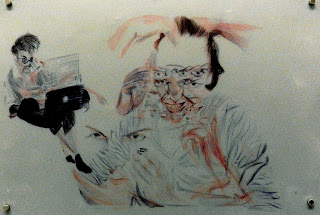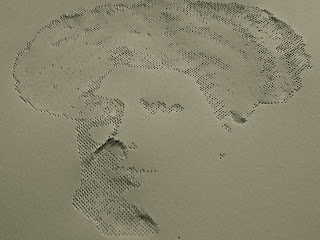It's our final year at University. Sad, exciting, scary, vaguely unreal...
Post-graduation doesn't seem tangible to me yet.
However, so far I do know I have learned a lot.
It is very tempting for me to dive into the combined life lessons the past three years have thrown up.
Becoming a 'grown up', moving out, taking on full financial responsibilities, making independent choices about my artwork and knowing why exactly I have made them, new music, new people, new countries and new career prospects - and really getting my teeth stuck into research... so I need to focus.
Like I said at the new year: stay calm, and focus, focus and stay calm.
This post is essentially a review of my third year studio practice.
The tail end of the degree, but a sound starting point for everything after.
- - - - - -
 |
White acrylic and biro on unprimed canvas.
Capturing fragments, selecting details.
|
Influenced by a scientific article on the mechanics of sight, I began by capturing segments of detail I was drawn to in conversations and observations of people.
I began manipulating the form to keep up with the changing movement as my eye was drawn to different fragments of detail.
(I am a big fan of the New Scientist - they offer a wide variety of topics for an artist to explore.
Also, they do a fantastic deal if you are a student, though I use the library's collection for inspiration.)
The key factors were visual selection, perception of one another and the translation of digital to tactile in both conversation and artwork drawing upon this topic.
In order to give my work some parameters, I used the frame of a monitor screen commonly used for online communication. My aunt Paula and her husband Ergin met through online RPG gaming, and continued to game together after moving in. It's a modern love story, and an interesting model for this topic. I wrote up some instructions and sent them over to record a ten minute online conversation between the two of them. The setup of their webcams were completely their own decision, which led to an interesting twist to the work...in the top left corner of Ergin's frame, Paula was in view for the entire conversation on her laptop. This added to the idea of technology manipulating our normal frame of perspective (being able to see yourself in the background of the person you are talking to...).
The resulting drawings have a surrealistic, Bacon feel, but were directed completely through their observations.
This experience was rendered in biro material, using systematic resourcing and layering.
I used the last observations at the top layer and worked backwards, omitting layers that would have been covered up by the top layers.
This was my first experimentation with representing the passing of time within the work.
These were very small drawings, too, around A5 and referenced to screenshots of the conversation at hand.
I was still testing where this project could lead, so decided to try a video installation of the original feed. The placement of the screens created new physical bodies back into the dynamics, but after a few meditations I decided upon a standard side by side, uniform layout with no audio playback.
The feedback from this strongly noted the colour scheme of the two videos (also uncontrolled) and the slow recognition of Paula in both screens.
Outcome: A video installation with observational plotlines
At the time I had been interested in William Kentridge and Picasso. From the reactions I began looking more into Bacon and Hockney as key artists of research. I felt the influence and interest in Picasso was most relevant to me in my practice, and didn't want to become too influenced by work very close to my investigations.
- - - - - -
Later Dan Hays, Kusama and Marina Abramovij would lead my research into the 'Pixels'.
Methodical, repetitive, meditative. This was a good outlet for my work - very addictive and all consuming but productive, leaving me fresh to continue my research and drawing. This project looked into our online identities, recreating a tangible presence and dedicating time and attention to those we connect to on networking sites.
- - - - - -
In the third year, I continued with the conversation piece. I decided to keep the same method and change the material I was drawing on. In an attempt to reference the monitor screen or incorporate light into my work, I used architect paper to draw on.
The new subjects, Jake and Adam, used the same instructions, by witnessing this in person I was able to adapt them so it was easier to use. I also gathered more feedback directly from the participants in order to inform my work.
After working in A5 size again, I decided to try scaling up to life size drawings. I had to use pencil only, as colour would distract me from the composition itself.
Outcome: A3 renderings in mechanical pencil
- - - - - -
Taking a step back, 'stills' revisited each frame from the online video feed. I began creating frail, simple drawings of each frame, noting the time of capture in the top left corner. The frailty of the drawings reflected them as fleeting moments. The shadows emphasised taking the stills from the video reel and into a tangible form.
I started hanging them up in a passageway. The breeze of people walking past forced an interaction with the viewers, as the 'stills' fluttered around their steps.
- - - - - -






























